UVOD
Stacionarni dio Odjela za anesteziju, reanimaciju i intenzivno liječenje SKB Mostar se nalazi na preko 1000 m² novoizgrađenog, moderno projektiranog prostora koji je opremljen najsuvremenijim uređajima za strojnu potporu disanjem i monitoring bolesnika te pontinim sustavom instalacija s plinovima te negativnom sukcijom.. U sklopu Odjela se nalazi: Opća jedinica intenzivnog liječenja podijeljena u dvije prostorije (obje sobe po 151 m²), dvije izolacijske sobe (ukupno 73 m²), Kardiokirurška jedinica intenzivnog liječenja (110 m²), liječničke prostorije (116 m²), sobe za dežurne liječnike i soba za sastanke (ukupno 70 m²) te dodatni propusnici.. Ukupno se u obje jedinice intenzivnog liječenja nalazi 16 kreveta što znači da površina koja pripada jednom krevetu bez spremišta iznosi 25 m² što čini pretpostavku za kvalitetan proces, a u konačnici i za povoljniji ishod liječenja.
Svaki bolesnički krevet u JIL-u opremljen je respiratorom, monitorom na kojem se prate vitalni parametri (EKG, SpO2, neinvazivno i invazivno mjerenje arterijskog tlaka, mjerenje središnjeg venskog, plućnog arterijskog i intrakranijalnog tlaka), infuzomatom, perfuzorom, aspiratorom, stalkom za infuzije i ormarićem za bolesnika što sve zahtjeva ne samo održavanje imenovanih aparata već i svladavanje ispravnog rukovanja takvim aparatima. Zbog sofisticiranosti današnjeg monitoringa neophodno je da med. sestre/tehničari u JILu vladaju engleskim jezikom.
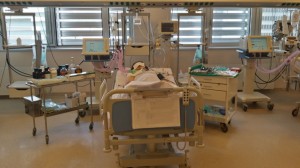
U JIL-u se liječe najteži bolesnici, nerijetko vitalno ugroženi, široke patologije (kirurški, neurološki, pulmološki, internistički, onkološki, ginekološki…). Kroz JIL godišnje „prođe“ oko 900 bolesnika. Trenutačno na našem Odjelu radi 54 medicinske sestre i tehničara, od toga 11 u Kardiokirurškoj jedinici intenzivnog liječenja, a ostatak u Općem JIL-u. U turnusu u KJIL-u rade po dvije sestre, a u OJIL-u 6-8 sestara.
Medicinske sestre/tehničaru JIL-u vrše intenzivnu zdravstvenu njegu vitalno ugroženih bolesnika, praćenje i nadzor istih kroz 24 sata. Bolesnici koji zahtijevaju potporu respiratora prilikom njege bolesnika budu priključeni na pokretni respirator koji održava i provjerava medicinska sestra/tehničar u JIL-u. Zahvaljujući trudu medicinskih sestara/tehničara i postojanju pokretnog respiratora i bolesnicima koji se strojno ventiliraju omogućeno je svakodnevno kupanje u kadi u odvojenim prostorijama (uz nadzor specijalizanta anesteziologije i reanimatologije). Ovdje ističemo da je velika razlika raditi zdravstvenu njegu s nepokretnim bolesnikom i zdravstvenu njegu bolesnika koji je nepokretan i na strojnoj ventilaciji.
Uz već navedene, ostale dužnosti med.sestara/tehničara u JIL-u su njega usne šupljine 4 puta dnevno, prevencija dekubitusa okretanjem bolesnika svaka dva sata (po potrebi i češće) uz masiranje predilekcijskih mjesta hidratantnim kremama, česta aspiracija bolesnika, plasiranje IV kanile, plasiranje urinarnog katetera , plasiranje nazogastrične sonde, često dnevno uzimanje uzoraka krvi iz periferne i centralne vene za laboratorijske pretrage, uzimanje uzoraka za mikrobiološke pretrage, podjela terapija bolesnicima kroz 24 h koja je upisana na temperaturnim listama, kontuirano mjerenje i upisivanje vitalnih parametara, ishrana bolesnika na nazogastričnu sondu i do 8 puta dnevno, naručivanje krvnih pripravaka te donošenje istih s transfuzije, provjeravanje i uključivanje krvi i krvnih pripravaka i po nekoliko puta dnevno, briga o dnevnom balansu tekućine bolesnika, čišćenje okoline bolesnika u svrhu sprječavanja unutarbolničkih infekcija, vođenje sestrinske dokumentacije za sve bolesnike, te uredno vođenje protokola i BIS-a (bolnički informacijski sustav).
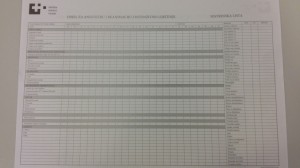
Med.sestre/tehničari u JIL-u pored cjelokupnog monitoringa sudjeluju i u pripremi aparata za akutnu dijalizu i samostalno je provode u dogovoru s dežurnim anesteziologom.
Također, sudjeluju i u svakodnevnoj bronhoskopskoj toaleti dišnih puteva, kao i pri plasiranju perkutane traheostome, reanimacijama i intubacijama, lumbalnim punkcijama, plasiranju središnjih venskih katetera te pratnji bolesnika iz JIL-a na dijagnostičke pretrage (CT, MR, EEG, gastroskopija, RTG, scintigrafija…).
Prilikom prestanka potrebe za intenzivnim liječenjem bolesnika, primopredaja istog se vrši u JIL-u, pismeno i usmeno uz nadzor medicinske sestre/tehničara.
U protekloj godini u Jedinici intenzivnog liječenja medicinske sestre/tehničari su asistirale prilikom plasiranja 28 perkutanih traheostoma i 526 središnjih venskih katetera uz prethodnu pripremu materijala te psihičku i fizičku pripremu bolesnika. Također, urađene su 103 bronhoskopije gdje su medicinske sestre/tehničari također pripremali materijal i bolesnika, asistirali pri zahvatu te pravilno pohranili i dokumentirali preuzeti materijal i poslali na daljnju obradu. Uz navedeno, u JIL-u je urađeno 78 akutnih hemofiltracija gdje su medicinske sestre/tehničari pripremili sami aparat te nadzirali tijek hemofiltracije do okončanja postupka nakon čega je slijedilo raspremanje uređaja i dokumentiranje provedenog postupka.
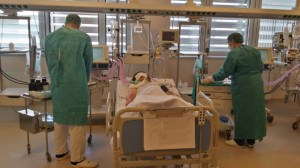
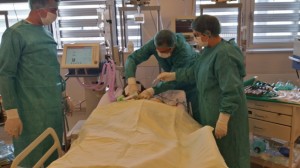
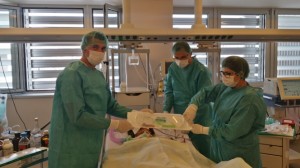
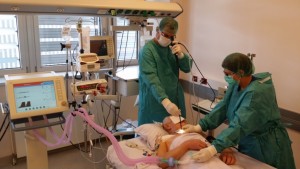
Naš odjel u sklopu kojeg se nalazi Jedina intenzivnog liječenja je nastavna baza Medicinskog fakulteta, Fakulteta zdravstvenih studija i Srednje medicinske škole te medicinske sestre aktivno sudjeluju u edukaciji kadra s navedenih ustanova.
Rad u Jedinici intenzivnog liječenja osim stručno-medicinskog znanja koje ima specifičnosti kako zbog životne ugroženosti bolesnika tako i zahtjevnosti pripreme opreme traži neizostavno timski rad. Komunikacija između medicinskih djelatnika treba biti brza, i često traži samoinicijativnost i samoorganizaciju u rješavanju novonastalih potreba od strane bolesnika. Sve gore navedeno čini rad medicinskom osoblju u JIL-u zahtjevnijim u odnosu na ostale odjele u bolnici
Zbog svega istaknutog stvara se potreba za otvaranje smjera uske specijalizacije za medicnske sestre/tehničare na Fakultetu zdravstvenih studija gdje bi se studenti obrazovali za složene zadaće koje ih čekaju u JIL-u.
ROLE OF NURSES / TECHNICIANS IN INTENSIVE CARE UNIT
Author:
Slavica Šimić, medical nurse
Department of Anesthesia, Resuscitation and Intensive Care
University Clinical Hospital Mostar
INTRODUCTION
The stationary part of the Department of Anesthesia, Resuscitation and Intensive Care of University Clinical Hospital Mostar is situated on over 1,000 m2 newly built, modern designed space that is equipped with modern devices for mechanical breathing support and monitoring of the patients and the Pontine system installations with emissions and negative suction. Department consist of:
- General intensive care unit is divided into two rooms (both rooms on 151 m²)
- Two isolation rooms (total 73 sq m)
- Cardiothoracic intensive care unit (110 sq m)
- Medical facilities (116 m²)
- Rooms for duty doctors and meeting rooms (70 m²)
- Additional Passes
Total in both the intensive care units consists of 16 beds which means that the area which belongs to a bed (without storage) is 25 m² which makes the assumption of a quality process, and ultimately to better patient treatment outcomes.
Each bedside in the intensive care unit is equipped with a respirator and monitor for vital parameters (ECG, SpO2, non-invasive and invasive arterial blood pressure measurement, measurement of central venous, pulmonary artery and intracranial pressure), infusomats, perfusor, extractor fan, stand for infusion and storage for patients that requiresadequate knowledge of maintenance the designations of apparatus, but also mastering the proper handling of such devices.
Because of the sophistication of today’s monitoring it is necessary adequate knowledge of English language by medical nurses/technicians employed in intensive care units.

Intensive care unit accepts most serious patients, often critically ill, broad pathology (surgical, neurological, Pulmonology, Internal medicine, oncology, gynecology, …). Through intensive care unit annual “pass of patients” is approximately 900 patients. Currently, in our department are employed 54 nurses and technicians, of which 11 on the cardiac surgery intensive care unit, and the rest in the general intensive care unit. The shift in Critical intensive care unit has two sisters, and 6-8 nurses in the rest of department.
A Nurse/technician in the intensive care unit performs intensive health care of PICU patients, tracking and monitoring them for 24 hours. Patients who require the support of a respirator during patient care are connected to a movable respirator maintains and checks by the nurse/technician in the intensive care unit.
By virtue of the efforts of nurses/technicians and the existence of a moving respirator and patients who are mechanically ventilated enabled daily bathing in a tub in a separate room (under the supervision of trainee Anaesthesiology). Here we point out to a big difference to work with health care immobile patients and nursing care of patients who motionless on mechanical ventilation.
In addition to these, other duties of medical nurses/technicians in the intensive care unit is oral care mouth 4 times a day in order to prevent bed sores by turning the patient every two hours (more frequently if required) with massaging predilection sites moisturizer common aspiration of patients, the placement of IV-Cannula, urinary catheter placement, placement of a nasogastric tube, often taking daily blood samples from peripheral and central veins for laboratory tests, taking samples for microbiological analysis, classification therapy in patients over 24 hours, which is listed on the temperature charts, the continued measurement and registering vital parameters, nutrition of patients on nasogastric tube and up to 8 times a day, ordering of blood products and the adoption of the same with transfusions, checking and inclusion of blood components several times a day, taking care of the daily fluid balance of patients, cleaning the environment of patients in order to prevent intrahospital infections, managing nursing documentation for all patients, and orderly conduct of the protocol and the BIS (Hospital informationSystem).

Medical nurses/technicians in the intensive care unit in addition to the overall monitoring also participate in the preparation apparatus for acute dialysis and independently carried out in consultation with the anesthesiologist on duty.
Also participating in everyday bronchoscopic toilets airways, as well as the placement of percutaneous tracheostomy, resuscitation and intubation, lumbar puncture, placement of central venous catheters and escorted patients from the intensive care unit and the diagnostic tests (CT, MRI, EEG, gastroscopy, x-ray, scintigraphy …). At the termination of the need for intensive care patients, handover of the patient is done in the intensive care unit under the supervision of nurses/technicians. In the past year,nurses/tehnicians in the intensive care unit assisted in the placement of percutaneous tracheostomy of 28 and 526 central venous catheter with the prior preparation of the material and the mental and physical preparation of the patient. Also, we performed 103 bronchoscopies where nurses/technicians also prepared material and patients, assisting in surgery and properly stored and documented backing papers and sent for further processing. In addition, the they done 78 acute hemofiltration where nurses/technicians prepared apparatus and supervised course of hemofiltration to the completion of the procedure followed by clearing away the device and documentation of the conducted procedures.




Within our department is only intensive care teaching based on the Faculty of Medicine, Faculty of Health Studies and Secondary Medical school, also nurses are actively involved in the education of personnel with these institutions.
Work in the Intensive Care Unit except professional medical knowledge that has specificity to the threat to life of patients and complexity of preparing the equipment requested inevitably teamwork. Communication between health care professionals should be fast, and often seeks initiative and self-organization in addressing emerging needs of the patient. All of the above makes the work of medical staff in the intensive care unit demanding compared to other departments in the hospital.
Because of all the above there is a need for opening direction narrow specialization for medical nurses/ technicians at the Faculty of Health Studies where students are educated in the complex tasks that await them in the intensive care unit.